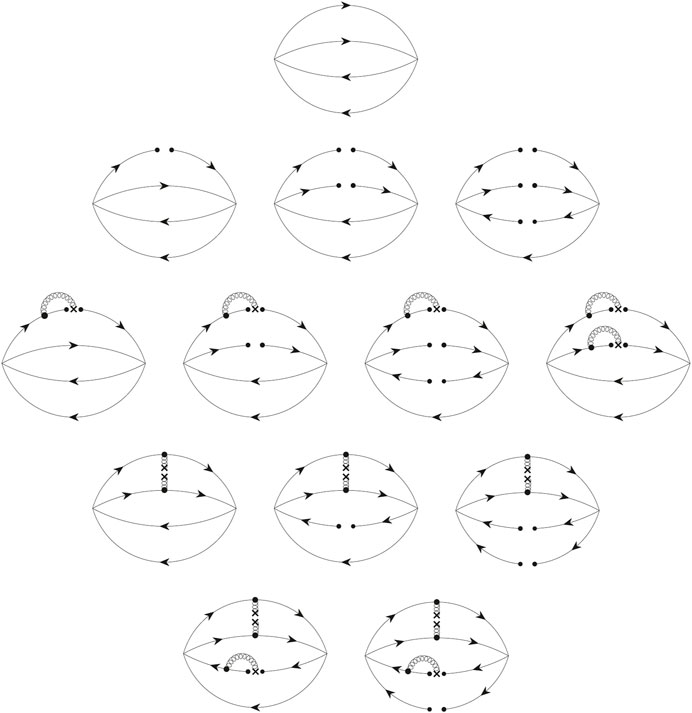- 1School of Physics, Southeast University, Nanjing, China
- 2College of Science, Northwest A&F University, Yangling, China
We apply the QCD sum rule method to systematically study the fully strange tetraquark states with the quantum number JPC = 2++. We construct both the diquark–antidiquark and mesonic–mesonic currents and calculate both their diagonal and off-diagonal correlation functions. Based on the obtained results, we further construct three mixing currents that are nearly non-correlated. We use one mixing current to extract the mass of the lowest-lying state to be
1 Introduction
Many exotic hadrons were observed in particle experiments during the past 20 years [1], some of which are good candidates for the fully strange tetraquark states [2–22]. Especially the BESIII collaboration performed a partial wave analysis of the J/ψ → γϕϕ decay in 2016 [23]. They observed three tensor resonances, namely, f2(2010), f2(2300), and f2(2340) in the ϕϕ invariant mass spectrum, whose masses and widths were measured to be
These three resonances contain many strangeness components, so they are possible fully strange tetraquark states of JPC = 2++. With a large amount of the J/ψ sample, BESIII collaborations are still examining the physics happening in this energy region, and more rich-strangeness signals are expected in the coming future. Similar experiments can also be performed by Belle-II, COMPASS, GlueX, and PANDA, etc.
The fully strange tetraquark states are interesting from two aspects. Experimentally, their widths are possibly not very broad [possibly at the order of
In this paper, we shall study the fully strange tetraquark states with the quantum number JPC = 2++. We shall systematically construct both the diquark–antidiquark and mesonic–mesonic currents. We shall apply the method of QCD sum rules to study these currents as a whole, and extract the mass of the lowest-lying state to be
This paper is organized as follows. In Section 2, we systematically construct the fully strange tetraquark states with the quantum number JPC = 2++. We use these currents to perform QCD sum rule analyses in Section 3, where we calculate both their diagonal and off-diagonal correlation functions. Based on the obtained results, we use the diquark–antidiquark currents to perform numerical analyses in Section 4, and we use their mixing currents to perform numerical analyses in Section 5. The obtained results are summarized and discussed in Section 6.
2 Interpolating currents
The fully strange tetraquark currents with quantum numbers JPC = 0−+/1±±/4+− have been systematically constructed in [24–30, 43]. In this section, we follow the same approach to construct the fully strange tetraquark currents with the quantum number JPC = 2++. We observe three independent diquark–antidiquark currents.
where a and b are color indices, C = iγ2γ0 is the charge-conjugation operator, and the symbol
In addition to the aforementioned diquark–antidiquark currents, we find six mesonic–mesonic currents.
We can verify the following relations through the Fierz rearrangement, so the number of independent mesonic–mesonic currents is also three.
Moreover, we can use the Fierz rearrangement to relate the diquark–antidiquark and mesonic–mesonic currents.
Therefore, the diquark–antidiquark and mesonic–mesonic constructions are equivalent to each other, when the local currents are investigated. We shall use this Fierz identity to study the decay behaviors at the end of this paper.
3 QCD sum rule analysis
The QCD sum rule method is a powerful and successful non-perturbative method [44, 45]. In this section, we apply it to study the currents
at both the hadron and quark–gluon levels. Here,
At the hadron level, we generally assume that the currents
where fin is the decay constant and ϵμν is the symmetric and traceless polarization tensor. Then, we use the dispersion relation to express Πij(q2) as
where
where Mn is the mass of Xn and ⋯ is contributed by the continuum. It should be noted that the widths of Xn are not taken into account in the present study, and the two-meson thresholds are also not taken into account, such as the ϕϕ threshold. The Fierz rearrangement given in Eq. 13 indicates that the tetraquark currents
At the quark–gluon level, we apply the method of the operator product expansion (OPE) to calculate Eq. 15 and extract the OPE spectral density
Finally, we perform the Borel transformation at both the hadron and quark–gluon levels. After approximating the continuum using ρij(s) above the threshold value s0, we arrive at the sum rule equation
The explicit sum rule equations extracted from the currents
For completeness, we have calculated both the diagonal and off-diagonal correlation functions. We shall investigate them using two steps, the single-channel analysis and the multi-channel analysis, in the following sections.
4 Single-channel analysis
In this section, we perform the single-channel analysis. To perform this, we simply neglect the off-diagonal correlation functions; i.e., we assume ρij(s)|i≠j = 0 so that only ρii(s) ≠ 0. Under this assumption, any two of the three currents
This allows us to further assume that the three currents
with fii ≠ 0 and fij = 0 for i, j = 1⋯3 and i ≠ j.
Now, we can parameterize the diagonal spectral density ρii(s) as one-pole dominance for the state Xi and a continuum contribution. This simplifies Eq. 19 to be
It can be used to calculate Mi through
We use the spectral density ρ11(s) given in Eq. 20 as an example to perform the single-channel numerical analysis. We take the following values for various sum rule parameters [1, 47–53]:
Equation 29 states that mass M1 depends on two free parameters, the threshold value s0, and the Borel mass MB. We consider three aspects to determine their working regions: a) the convergence of OPE, b) the sufficient amount of pole contribution, and c) the stability of the mass dependence on these two parameters.
First, we investigate the convergence of OPE, which is the cornerstone of a reliable QCD sum rule analysis. We require the D = 12/10/8 terms to be less than 5%/10%/20%, respectively.
Figure 2 shows that through the dashed curves, the lower bound of the Borel mass is determined to be
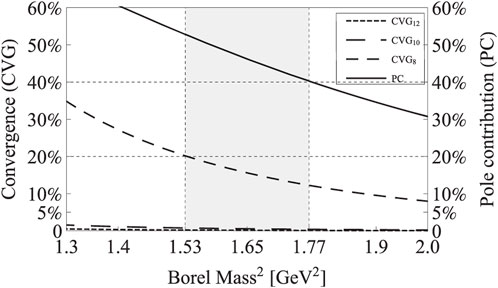
FIGURE 2. CVG12/10/8 and PC with respect to the Borel mass MB. These curves are obtained using the spectral density ρ11(s) given in Eq. 20, when setting s0=6.5 GeV2.
Second, we investigate the one-pole-dominance assumption by requiring the pole contribution to be larger than 40%:
Figure 2 shows that through the solid curve, the upper bound of the Borel mass is determined to be
Third, we investigate the stability of the mass dependence on s0 and MB. As shown in Figure 3, we find a mass minimum around s0 ≈ 3 GeV2, and the mass dependence on s0 is moderate inside the region 5.5 GeV2 ≤ s0 ≤ 7.5 GeV2. As shown in Figure 4, the mass dependence on MB is rather weak inside the Borel window 1.53
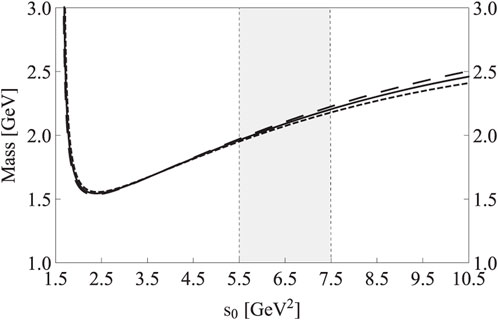
FIGURE 3. Mass M1 of the state X1 with respect to the threshold value s0. Short-dashed/solid/long-dashed curves are obtained by setting
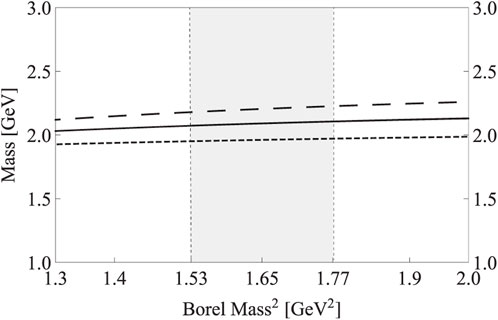
FIGURE 4. Mass M1 of the state X1 with respect to the Borel mass MB. Short-dashed/solid/long-dashed curves are obtained by setting s0=5.5/6.5/7.5 GeV2, respectively. These curves are obtained using the spectral density ρ11(s) given in Eq. 20.
Altogether, we determine our working regions to be 5.5 GeV2 ≤ s0 ≤ 7.5 GeV2 and 1.53
Its central value is obtained by setting s0 = 6.5 GeV2 and
We follow the same procedures to study the other two currents,
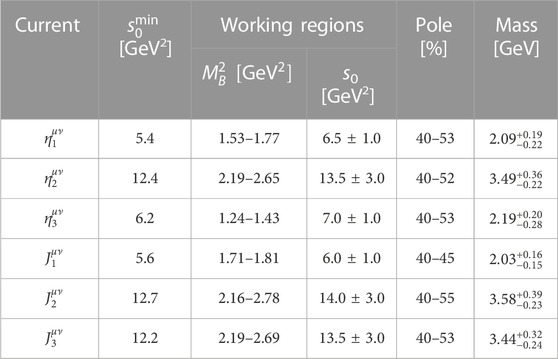
TABLE 1. QCD sum rule results for the fully strange tetraquark states with the quantum number JPC =2++, extracted from the diquark–antidiquark currents
5 Multi-channel analyses
In this section, we perform the multi-channel analyses. To perform this, we do not neglect the off-diagonal correlation functions any more, i.e., ρij(s)|i≠j ≠ 0. When setting s0 = 6.0 GeV2 and
Therefore,
In order to diagonalize the 3 × 3 matrix
where
We use
when setting
as well as s0 = 6.0 GeV2 and
Now, we can use the procedures applied in the previous section on the currents
as shown in Figures 5, 6 with respect to the threshold value s0 and the Borel mass MB.
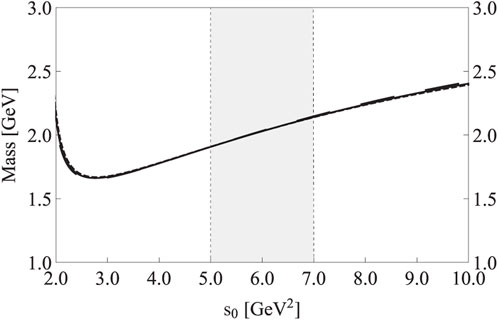
FIGURE 5. Mass
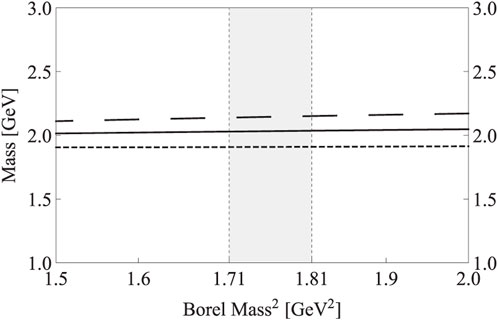
FIGURE 6. Mass
6 Summary and discussions
In this paper, we use the QCD sum rule method to study the fully strange tetraquark states with the quantum number JPC = 2++. We systematically construct their interpolating currents and find three independent diquark–antidiquark currents, denoted as
Particularly, we use the mixing current
In this paper, we also systematically construct the fully strange mesonic–mesonic currents of JPC = 2++, which can be related to the diquark–antidiquark currents through the Fierz rearrangement. In particular, we can apply Eqs. 37 and 39, and Eq. 14 to transform the mixing current
This Fierz identity suggests that the lowest-lying state dominantly decays into the S-wave ϕ(1020)ϕ(1020) channel through the mesonic–mesonic current
Data availability statement
The original contributions presented in the study are included in the article/Supplementary Material; further inquiries can be directed to the corresponding authors.
Author contributions
All authors listed have made a substantial, direct, and intellectual contribution to the work and approved it for publication.
Funding
This project was supported by the National Natural Science Foundation of China under grant no. 12075019, the Jiangsu Provincial Double-Innovation Program under grant no. JSSCRC2021488, and the Fundamental Research Funds for the Central Universities.
Conflict of interest
The authors declare that the research was conducted in the absence of any commercial or financial relationships that could be construed as a potential conflict of interest.
Publisher’s note
All claims expressed in this article are solely those of the authors and do not necessarily represent those of their affiliated organizations, or those of the publisher, the editors, and the reviewers. Any product that may be evaluated in this article, or claim that may be made by its manufacturer, is not guaranteed or endorsed by the publisher.
References
1. Zyla PA, Barnett RM, Beringer J, Dahl O, Dwyer DA, Groom DE, et al. Review of particle physics. PTEP (2020) 2020(8):083C01. doi:10.1093/ptep/ptaa104
2. Chen H-X, Chen W, Liu X, Zhu S-L. The hidden-charm pentaquark and tetraquark states. Phys Rept (2016) 639:1–121. doi:10.1016/j.physrep.2016.05.004
3. Liu Y-R, Chen H-X, Chen W, Liu X, Zhu S-L. Pentaquark and tetraquark states. Prog Part Nucl Phys (2019) 107:237–320. doi:10.1016/j.ppnp.2019.04.003
4. Chen H-X, Chen W, Liu X, Liu Y-R, Zhu S-L. An updated review of the new hadron states. Rept Prog Phys (2023) 86(2):026201. doi:10.1088/1361-6633/aca3b6
5. Lebed RF, Mitchell RE, Swanson ES. Heavy-quark QCD exotica. Prog Part Nucl Phys (2017) 93:143–94. doi:10.1016/j.ppnp.2016.11.003
6. Esposito A, Pilloni A, Polosa AD. Multiquark resonances. Phys Rept (2017) 668:1–97. doi:10.1016/j.physrep.2016.11.002
7. Hosaka A, Iijima T, Miyabayashi K, Sakai Y, Yasui S. Exotic hadrons with heavy flavors: X, Y, Z, and related states. PTEP (2016) 2016(6):062C01. doi:10.1093/ptep/ptw045
8. Guo F-K, Hanhart C, Meißner U-G, Wang Q, Zhao Q, Zou B-S. Hadronic molecules. Rev Mod Phys (2018) 90(1):015004. doi:10.1103/RevModPhys.90.015004
9. Ali A, Lange JS, Stone S. Exotics: Heavy pentaquarks and tetraquarks. Prog Part Nucl Phys (2017) 97:123–98. doi:10.1016/j.ppnp.2017.08.003
10. Olsen SL, Skwarnicki T, Zieminska D. Nonstandard heavy mesons and baryons: Experimental evidence. Rev Mod Phys (2018) 90(1):015003. doi:10.1103/RevModPhys.90.015003
11. Karliner M, Rosner JL, Skwarnicki T. Multiquark states. Ann Rev Nucl Part Sci (2018) 68:17–44. doi:10.1146/annurev-nucl-101917-020902
12. Bass SD, Moskal P. η′ and η mesons with connection to anomalous glue. Rev Mod Phys (2019) 91(1):015003. doi:10.1103/RevModPhys.91.015003
13. Brambilla N, Eidelman S, Hanhart C, Nefediev A, Shen C-P, Thomas CE, et al. The XYZ states: Experimental and theoretical status and perspectives. Phys Rept (2020) 873:1–154. doi:10.1016/j.physrep.2020.05.001
14. Guo F-K, Liu X-H, Sakai S. Threshold cusps and triangle singularities in hadronic reactions. Prog Part Nucl Phys (2020) 112:103757. doi:10.1016/j.ppnp.2020.103757
15. Ketzer B, Grube B, Ryabchikov D. Light-meson spectroscopy with COMPASS. Prog Part Nucl Phys (2020) 113:103755. doi:10.1016/j.ppnp.2020.103755
16. Yang G, Ping J, Segovia J. Tetra- and penta-quark structures in the constituent quark model. Symmetry (2020) 12(11):1869. doi:10.3390/sym12111869
17. Roberts CD, Richards DG, Horn T, Chang L. Insights into the emergence of mass from studies of pion and kaon structure. Prog Part Nucl Phys (2021) 120:103883. doi:10.1016/j.ppnp.2021.103883
18. Fang S-S, Kubis B, Kupść A. What can we learn about light-meson interactions at electron-positron colliders? Prog Part Nucl Phys (2021) 120:103884. doi:10.1016/j.ppnp.2021.103884
19. Jin S, Shen X. Highlights of light meson spectroscopy at the BESIII experiment. Natl Sci Rev (2021) 8(11):nwab198. doi:10.1093/nsr/nwab198
20. Albaladejo M, Bibrzycki L, Dawid SM, Fernandez-Ramirez C, Gonzalez-Solis S, Hiller Blin AN, et al. Novel approaches in hadron spectroscopy (2021). Available at: https://arxiv.org/abs/2112.13436 (Accessed December 26, 2021).
21. Meng L, Wang B, Wang G-J, Zhu S-L. Chiral perturbation theory for heavy hadrons and chiral effective field theory for heavy hadronic molecules. Available at: https://arxiv.org/abs/2204.08716 (Accessed April 19, 2022).
22. Brambilla N, Chen H-X, Esposito A, Ferretti J, Francis A, Guo F-K, et al. Substructure of multiquark hadrons (snowmass 2021 white paper). Available at:https://arxiv.org/abs/2203.16583 (Accessed March 30, 2022).
23. Ablikim M, Achasov M, Ai X, Albayrak O, Albrecht M, Ambrose D, et al. Observation of pseudoscalar and tensor resonances in J/ψ → γϕϕ. Phys Rev D (2016) 93(11):112011. doi:10.1103/PhysRevD.93.112011
24. Chen H-X, Liu X, Hosaka A, Zhu S-L. Y(2175) state in the QCD sum rule. Phys Rev D (2008) 78:034012. doi:10.1103/PhysRevD.78.034012
25. Chen H-X, Hosaka A, Zhu S-L. IGJPC = 1−1−+ tetraquark states. Phys Rev D (2008) 78:054017. doi:10.1103/PhysRevD.78.054017
26. Chen H-X, Hosaka A, Zhu S-L. IGJPC = 0+1−+ tetraquark states. Phys Rev D (2008) 78:117502. doi:10.1103/PhysRevD.78.117502
27. Chen H-X, Shen C-P, Zhu S-L. Possible partner state of the Y(2175). Phys Rev D (2018) 98(1):014011. doi:10.1103/PhysRevD.98.014011
28. Cui E-L, Yang H-M, Chen H-X, Chen W, Shen C-P. QCD sum rule studies of $$s s {\bar{s}} {\bar{s}}$$ s s s ¯ s ¯ tetraquark states with $$J^{PC} = 1^{+-}$$ J PC = 1 + -s s {\bar{s}} {\bar{s}} tetraquark states with JPC = 1+−. Eur Phys J C (2019) 79(3):232. doi:10.1140/epjc/s10052-019-6755-y
29. Dong R-R, Su N, Chen H-X, Cui E-L, Zhou Z-Y. QCD sum rule studies on the $$s s {\bar{s}} {\bar{s}}$$ tetraquark states of $$J^{PC} = 0^{-+}$$s s \bar{s} \bar{s} tetraquark states of JPC = 0−+. Eur Phys J C (2020) 80(8):749. doi:10.1140/epjc/s10052-020-8340-9
30. Dong R-R, Su N, Chen H-X. Highly excited and exotic fully-strange tetraquark states. Eur Phys J C (2022) 82(11):983. doi:10.1140/epjc/s10052-022-10955-0
31. Chen H-X, Chen W, Liu X, Liu X-H. Establishing the first hidden-charm pentaquark with strangeness. Eur Phys J C (2021) 81(5):409. doi:10.1140/epjc/s10052-021-09196-4
32. Chen H-X. Hadronic molecules in B decays. Phys Rev D (2022) 105(9):094003. doi:10.1103/PhysRevD.105.094003
33. Wang Z-G. Analysis of as a tetraquark state with QCD sum rules. Nucl Phys A (2007) 791:106–16. doi:10.1016/j.nuclphysa.2007.04.012
34. Wang Z-G. Light tetraquark state candidates. Adv High Energ Phys. (2020) 2020:1–7. doi:10.1155/2020/6438730
35. Agaev SS, Azizi K, Sundu H. Nature of the vector resonance Y(2175). Phys Rev D (2020) 101(7):074012. doi:10.1103/PhysRevD.101.074012
36. Azizi K, Agaev SS, Sundu H. Light axial-vector and vector resonances X(2100) and X(2239. Nucl Phys B (2019) 948:114789. doi:10.1016/j.nuclphysb.2019.114789
37. Pimikov AV. Nonlocal gluon condensates in QCD sum rules. Phys Rev D (2022) 106(5):056011. doi:10.1103/PhysRevD.106.056011
38. Liu F-X, Liu M-S, Zhong X-H, Zhao Q. Fully-strange tetraquark ss\bar{s}\bar{s} spectrum and possible experimental evidence. Phys Rev D (2021) 103(1):016016. doi:10.1103/PhysRevD.103.016016
39. Lü Q-F, Wang K-L, Dong Y-B. The tetraquark states and the structure of X(2239) observed by the BESIII collaboration *ss \bar{s} \bar{s} tetraquark states and the newly observed structure X(2239) by BESIII Collaboration. Chin Phys C (2020) 44(2):024101. doi:10.1088/1674-1137/44/2/024101
40. Deng C, Ping J, Wang F, Goldman T. Tetraquark state and multibody interaction. Phys Rev D (2010) 82:074001. doi:10.1103/PhysRevD.82.074001
41. Drenska NV, Faccini R, Polosa AD. Higher tetraquark particles. Phys Lett B (2008) 669:160–6. doi:10.1016/j.physletb.2008.09.038
42. Ebert D, Faustov RN, Galkin VO. Masses of light tetraquarks and scalar mesons in the relativistic quark model. Eur Phys J C (2009) 60:273–8. doi:10.1140/epjc/s10052-009-0925-2
43. Su N, Chen H-X. S- and P-wave fully strange tetraquark states from QCD sum rules. Phys Rev D (2022) 106(1):014023. doi:10.1103/PhysRevD.106.014023
44. Shifman MA, Vainshtein AI, Zakharov VI. QCD and resonance physics. theoretical foundations. Nucl Phys B (1979) 147:385–447. doi:10.1016/0550-3213(79)90022-1
45. Reinders LJ, Rubinstein H, Yazaki S. Hadron properties from QCD sum rules. Phys Rept (1985) 127:1–97. doi:10.1016/0370-1573(85)90065-1
46. Lucha W, Melikhov D, Sazdjian H. Tetraquark-adequate formulation of QCD sum rules. Phys Rev D (2019) 100(1):014010. doi:10.1103/PhysRevD.100.014010
47. Yang K-C, Hwang WYP, Henley EM, Kisslinger LS. QCD sum rules and neutron-proton mass difference. Phys Rev D (1993) 47:3001–12. doi:10.1103/PhysRevD.47.3001
48. Narison S. QCD as a theory of hadrons: From partons to confinement. Oxford, UK: Oxford University Press (2005).
49. Gimenez V, Lubicz V, Mescia F, Porretti V, Reyes J. Operator product expansion and quark condensate from lattice QCD in coordinate space. Eur Phys J C (2005) 41:535–44. doi:10.1140/epjc/s2005-02250-9
50. Jamin M. Flavour-symmetry breaking of the quark condensate and chiral corrections to the Gell-Mann–Oakes–Renner relation. Phys Lett B (2002) 538:71–6. doi:10.1016/S0370-2693(02)01951-2
51. Ioffe BL, Zyablyuk KN. Gluon condensate in charmonium sum rules with three-loop corrections. Eur Phys J C (2003) 27:229–41. doi:10.1140/epjc/s2002-01099-8
52. Ovchinnikov AA, Pivovarov AA. QCD sum rule calculation of the quark gluon condensate. Sov J Nucl Phys (1988) 48:721–3.
Keywords: exotic hadron, tetraquark state, QCD sum rules, Fierz rearrangement, interpolating current
Citation: Dong R-R, Su N, Chen H-X and Cui E-L (2023) QCD sum rule study on the fully strange tetraquark states of JPC = 2++. Front. Phys. 11:1184103. doi: 10.3389/fphy.2023.1184103
Received: 11 March 2023; Accepted: 22 May 2023;
Published: 07 June 2023.
Edited by:
Alberto Martinez Torres, University of São Paulo, BrazilReviewed by:
Feng-Kun Guo, Chinese Academy of Sciences (CAS), ChinaAlessandro Pilloni, National Institute of Nuclear Physics of Rome, Italy
Copyright © 2023 Dong, Su, Chen and Cui. This is an open-access article distributed under the terms of the Creative Commons Attribution License (CC BY). The use, distribution or reproduction in other forums is permitted, provided the original author(s) and the copyright owner(s) are credited and that the original publication in this journal is cited, in accordance with accepted academic practice. No use, distribution or reproduction is permitted which does not comply with these terms.
*Correspondence: Hua-Xing Chen, aHhjaGVuQHNldS5lZHUuY24=; Er-Liang Cui, ZXJsaWFuZy5jdWlAbndhZnUuZWR1LmNu
 Rui-Rui Dong
Rui-Rui Dong Niu Su
Niu Su Hua-Xing Chen
Hua-Xing Chen Er-Liang Cui
Er-Liang Cui